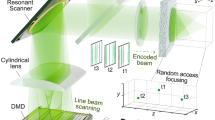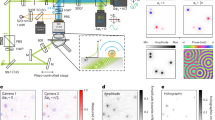Abstract
In its normal state, the eye lens is transparent despite the presence in the cell cytoplasm of high concentrations of proteins, the crystalline, which, a priori, could be expected to scatter an important part of the incident light. Early on, an explanation was sought in the spatial correlations between individual scatterers. Trokel1 first proposed that the "high concentration of proteins in the lens must be accompanied by a degree of local order approaching a paracrystalline state"; Benedek2 subsequently suggested that a dense, noncrystalline packing of the proteins would sufficiently reduce the scattered intensity. However, in spite of an improved understanding of the molecular structure of crystallins3–6, their spatial order remained unknown. We present here a small-angle X-ray scattering study of the problem, performed with calf lens cytoplasm both in intact lenses and in cytoplasmic extracts where the crystallin concentration was varied from 3 to 510 mg ml−1. All our experimental data are consistent with short-range spatial order, as in dense liquids or glasses7–9, and this provides a simple explanation for lens transparency2,10. In addition, we detected no conformational change or reorganization of the crystallin proteins throughout the investigated concentration range.
This is a preview of subscription content, access via your institution
Access options
Subscribe to this journal
Receive 51 print issues and online access
$199.00 per year
only $3.90 per issue
Buy this article
- Purchase on Springer Link
- Instant access to full article PDF
Prices may be subject to local taxes which are calculated during checkout
Similar content being viewed by others
References
Trokel, S. Invest. Ophthal. 1, 493–501 (1962).
Benedek, G. B. Appl. Opt. 10, 459–473 (1971).
Siezen, R. J., Bindels, J. G. & Hoenders, H. J. Eur. J. Biochem. 111, 435–444 (1980).
Andries, C. et al. Expl Eye Res. 34, 239–255 (1982).
Bloemendal, H. (ed.) in Molecular and Cellular Biology of the Eye Lens, 1–47 (Wiley-Interscience, New York, 1981).
Blundell, T. et al. Nature 289, 771–777 (1981).
Guinier, A. & Fournet, G. Small Angle Scattering of X-Rays (Wiley, New York, 1955).
Mikolaj, P. G. & Pings, C. J. J. chem. Phys. 46, 1401–1411 (1967).
Finney, J. L. Nature 266, 309–314 (1977).
Delaye, M. & Gromiec, A. Biopolymers (in the press).
Clark, J. I., Delaye, M., Hammer, P. & Mengel, L. Curr. Eye Res. 1 (12), 695–704 (1982).
Benedetti, E. L., Dunia, I., Ramaekers, F. C. S. & Kibbelaar, M. A. in Molecular and Cellular Biology of the Eye Lens (ed. Bloemendal, H.) 137–188 (Wiley-Interscience, New York, 1981).
Luzzati, V. Acta crystallogr. 13, 939–945 (1960).
Luzzati, V. & Tardieu, A. A. Rev. Biophys. Bioengng 9, 1–29 (1980).
Siezen, R. J. & Berger, H. Eur. J. Biochem. 91, 397–405 (1978).
Bindels, J. G. thesis, Nijmegen Univ. (1982).
Zinke, M., Damaschun, G., Muller, J. J. & Ruckpaul, K. Studia biophys. berl. 71, 135–136 (1978).
Thiele, E. J. chem. Phys. 39, 474–479 (1963).
Carnahan, N. F. & Starling, K. E. J. chem. Phys. 51, 635–636 (1969).
Gabriel, A. Rev. Sci. Instrum. 48, 1303–1305 (1977).
Sardet, C., Tardieu, A. & Luzzati, V. J. molec. Biol. 105, 383–407 (1976).
Eisenberg, H. Biological Macromolecules and Polyelectrolytes in Solution (Clarendon, Oxford, 1976).
Author information
Authors and Affiliations
Rights and permissions
About this article
Cite this article
Delaye, M., Tardieu, A. Short-range order of crystallin proteins accounts for eye lens transparency. Nature 302, 415–417 (1983). https://doi.org/10.1038/302415a0
Received:
Accepted:
Issue Date:
DOI: https://doi.org/10.1038/302415a0
This article is cited by
-
Senile Cataract Formation Does Not Affect Crystalline Lens Thickness
Ophthalmology and Therapy (2024)
-
Structure–function relationship of α-crystallin in the context of vertebrate lens evolution and its role in eye disorders
Journal of Proteins and Proteomics (2022)
-
Imbalances in the eye lens proteome are linked to cataract formation
Nature Structural & Molecular Biology (2021)
-
AlphaB-crystallin and breast cancer: role and possible therapeutic strategies
Cell Stress and Chaperones (2021)
-
The multifaceted nature of αB-crystallin
Cell Stress and Chaperones (2020)
Comments
By submitting a comment you agree to abide by our Terms and Community Guidelines. If you find something abusive or that does not comply with our terms or guidelines please flag it as inappropriate.



